Japanese Design Archive Survey
DESIGN ARCHIVE
Designers & Creators
Miyoko Ohno
Designer
Date: 12 July 2022, 13:30-15:30
Location: KOHIKAN(Setagaya)
Interviewees: Kazuko Ikegami(Former staff member, M & M Design Office)
Interviewers: Aia Urakawa
Author: Aia Urakawa
PROFILE
profile
Miyoko Ohno
Designer
1939 Born in Okayama Prefecture.
1963 Graduated from Tama Art University, Department of Design, worked at MATSUYA GINZA Interior Design Office.
1966-1968 Trained at Otto Glaus Architects in Switzerland (Japan External Trade Organisation Overseas Design Student).
1971 Established M&M Design Office.
2016 Passed away.
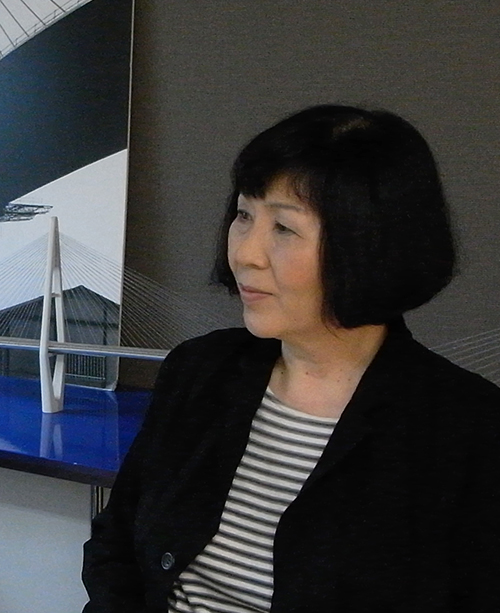
Description
Description
Starting out in furniture and interior design, Miyoko Ohno later expanded her domain to include exteriors, bringing design to the previously unlighted world of civil engineering and working to beautify and enrich Japan's cityscapes and landscapes. Her civil engineering work included bridges (footbridges, road bridges, highway bridges and railway bridges), protective fences and sound barriers, tunnel dragways and underpasses, and he worked with a careful eye for detail and an emphasis on thinking from the perspective of the consumer. In particular, she worked on 65 bridge designs, 19 of which received the Tanaka Award of the Japan Society of Civil Engineers, which is awarded for outstanding achievements in bridge and structural engineering.
Ohno's interest in bridge design was sparked by Sori Yanagi. After graduating from university and before leaving to study in Switzerland, Yanagi, who was working on a footbridge for Yawata Iron & Steel, asked him to collect data on bridges in Europe. Ohno collected the materials, made two copies, sent one to Yanagi and looked at the other for her own use, and became fascinated by bridge design.
After returning to Japan, she was led by fate to become involved in a diverse range of civil engineering work, including bridge design. Before her passing, she said.
"Until now, the world of civil engineering in Japan has been somewhat closed and has not been recognised by the public, despite the fact that it plays such an important role. Now, this is causing all sorts of harm. I hope that in the future, by actively disseminating information and creating beautiful bridges, the field will become familiar to people and all of us involved in bridge building can be proud of our work". ("Sutsuru kara Buriji made", M&M Design Office, 2018).
Ono's materials were donated to the Tama Art University Art Archives Center in 2021, and we spoke to Kazuko Ikegami, who had worked at M&M Design Office since the 1970s, about Miyoko Ohno's work, personality and the circumstances surrounding the donation.
Masterpiece
Masterpiece
Bridge design
"Hasune Footbridge" (1977); "Tatsumi no Mori Footbridge" (1970); "French bridge" (1984); "Katsushika Harp Bridge" (1986); "Yokohama Bay Bridge" (1989); "Tsurumi-bashi Bridge" (1990); "Tokyo Wan Aqua-Line Expressway" (1997); "Sakae Bridge Crossing on the Chiba Urban Monorail" (1998); "Ayunose bridge" (1999); "Jingashita Viaduct" (2001); "Kawasaki Muza deck" (2003); "Venus Wing Bridge" (2005), "JR Dosan Line railway viaduct" (2008), "Hamamirai Walk" (2009)
Other civil engineering works
"Bayshore Route Soundproofing walls in phases 1 and 2" (1982); "Sound barrier on the Mei-Nikan Expressway" (1988); "Tokyo - Gaikan Expressway sound barrier" (1992); "Airport North Tunnel shaft opening" (1993); "Underpass of Fukushima nishiizumi" (1995); "Sound insulation walls on the Tokai and Obu viaducts of the Ise-Wangan Expressway" (1998); "TMS type protective grilles" (1999); "Shintomi Refreshment Park" (2006); " Renovation of the overpass in front of Akihabara Station" (2013)
Products/Interiors
Club "Scotch Five" (1971); "Cypress Dining Set" (1972); "Living Space Unit" (1973); "Pine Stool" (1977); Interior design for the day room of Fujishiro Kensei Hospital (1976); "Standing Chair" (1988); "Gulliver's Chair" (2010)
Books
"Kyouryou Dezain Note", co-author, Japan Road Association (1992); "Korekara no Hodoukyou", co-author, gihodo shuppan (1998); "Ayunose Oohasi", M&M Design Office (2000); "Pede: Machi o Tsumugu Hodokyo Dezain", co-author, KAJIMA INSTITUTE PUBLISHING (2006); "BRIDGE: Fukei o Tsukuru Hasi", KAJIMA INSTITUTE PUBLISHING (2009); "Sutsuru kara Buriji made", M&M Design Office (2018)
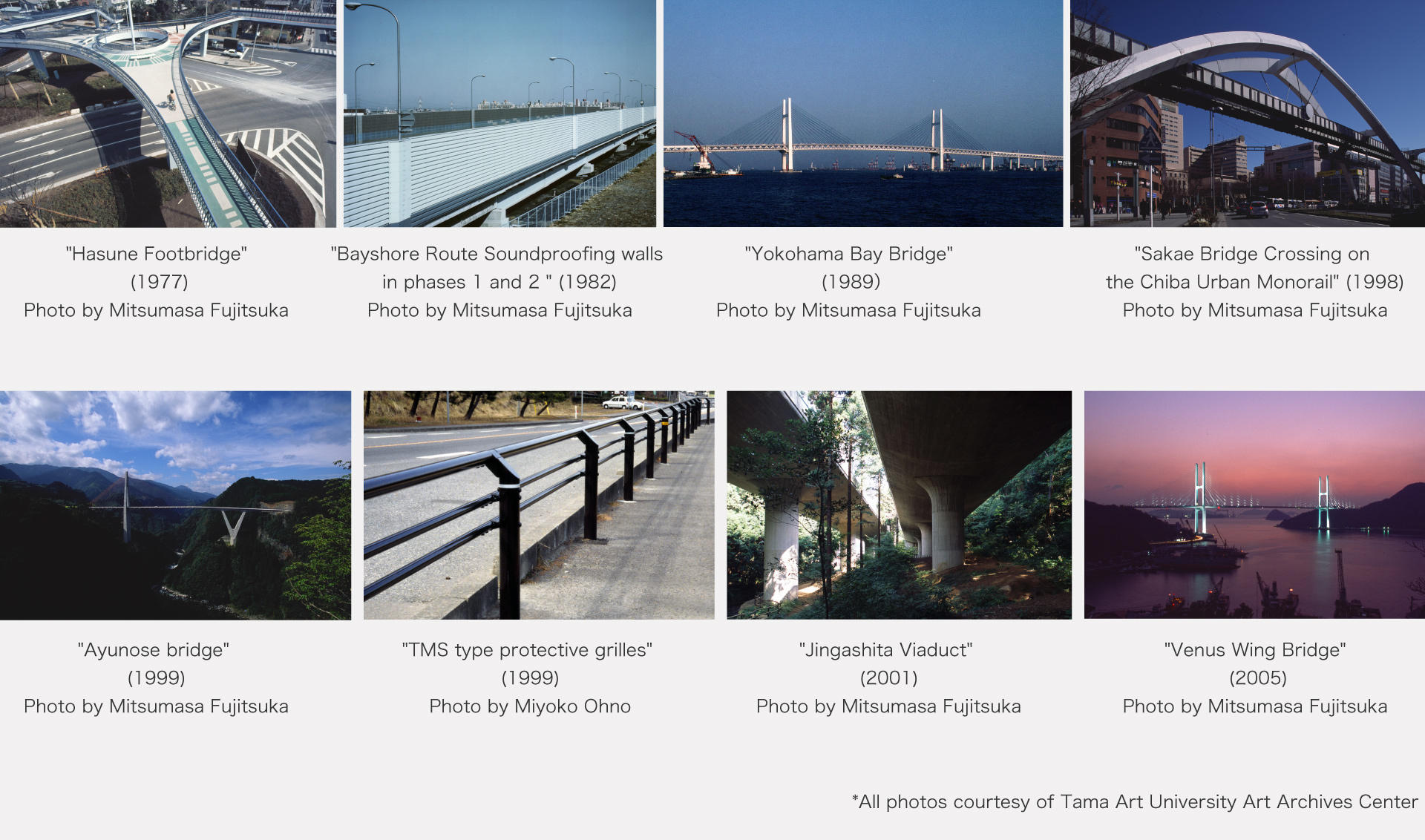
Interview
Interview
I hope that Ohno's materials will continue to be used as research material by students
Established M & M Design Office in the 1970s
ー M&M Design Office was co-founded by Ms. Miyoko Ohno and designer Ms. Midori Mitsui?
Ikegami Ohno and Ms. Midori are the same age and friends from their prep school days. Ohno went to Tama Art University and Ms. Mitsui went to Tokyo University of the Arts, but they were good friends from their school days. They both liked photography and used to go on photo trips to Tohoku together with backpacks on their backs. Later, Ohno went to Switzerland and Ms. Midori went to Denmark to study furniture, and I think they hit it off. After returning to Japan, they established the M & M Design Office together in 1971. M & M was named after the first letter "M" of their respective names (Miyoko and Midori).
ー What year did you join Ms. Ohno's office?
Ikegami I started working part-time as a third year university student in 1972, and at that time there were Ohno, Ms. Midori and a female staff member called Ms. Kyo Takeuchi. They were juniors at MATSUYA GINZA Interior Design Office, where Ohno had previously worked, and joined M&M Design Office in 1972. I joined the firm in 1974 after graduating from university.
ー How did you end up joining Ms. Ohno's office?
Ikegami I studied industrial design at university and wanted to pursue a career in furniture and interior design in the future. While I was still at school, I wanted to see the actual site, so I asked a design professional I knew if there was somewhere that would let me work part-time, and he introduced me to Ohno, who worked on furniture and interiors, and thought that would be a good place to start. I went there once or twice a week and almost every day during the spring, summer and winter university holidays to help out. I remember running around every day, going to specialised shops to have blue-burning drawings burnt, and visiting department stores to investigate how furniture was being sold at the time, as there was no internet.
People came from all over the place to work part-time in the office. Some of them became staff members. They may have put them in on a part-time basis at first to see if Ohno and the others would fit in with them or not. It was a small office, so I think they thought that compatibility was important.
ー You joined the office part-time in the very early days and stayed on as a staff member until the end, so you were a good fit with Ms. Ohno. What kind of person was Ms. Ohno like?
Ikegami I was there for a really long time, from shortly after the office was set up until we finally closed the office. Ohno was just a kind person. She was considerate, listened to what people had to say and was very easy to talk to. She didn't go into too many details, she was a very thoughtful person with a relaxed and easy-going atmosphere. Photographer Mr. Mitsumasa Fujitsuka once described Ohno as "a devil to the strong, but kind to the weak". She was very serious about his work. It is only natural, but she always made it a point to treat people with sincerity.
From furniture and interior design to civil engineering
ー Before that, in the 1970s and 1980s, after she returned to Japan from her studies in Switzerland, she worked in furniture and interior design.
Ikegami The furniture Ohno designed, for example the "Cypress Dining Set" with shelves and drawers for storing small plates, dried seaweed, tsukudani and other luxury items, was made with serious consideration of what people wanted and how they would use it in their daily lives, to suit the Japanese dining table. The "Standing Chair", with its one-letter form that allows the user to lean back in a standing position, was conceived when Ohno suffered a back injury, and was exhibited at the KAGU Tokyo Designer's Week '88 exhibition in 1988.
There is also a concept model called the "Living Space Unit", which was proposed for the Japanese living space of the near future. It consists of a unit-type cabinet, which allows each family member to have their own personal space, while at the same time creating a shared communication space. This furniture concept was later applied to a day room at Fujishiro Kensei Hospital, a psychiatric hospital in Hirosaki, Aomori Prefecture. A large hall with a tatami room, benches and warm wooden furniture was used to create a variety of spaces for different purposes, such as books, handicrafts, visits and meals. As Aomori is a place that tends to be closed off in winter due to deep snow, she wanted something beautiful and enjoyable. The work chair she designed at this time was later commercialised as the "Pine Stool".
ー Ms. Ohno's interest in care design was sparked when she was injured while skiing while studying in Switzerland and was struck by the beauty and comfort of the hospital where she was admitted, which subsequently led to her involvement in that Aomori mental hospital and geriatric hospital.
Ikegami She was very interested in working in care design. She was a member of the Japan Interior Designers' Association, and there was a kind of care design study group there, and she was quite enthusiastic and active, going to visit all the good places in geriatric care and rehabilitation facilities.
ー In addition to geriatric facilities and mental hospitals, what other places did she work on for interiors?
Ikegami She worked on shops, clinics and private homes, mostly in the 1970s and 1980s. The first interior design job she did was for a club called "Scotch Five" near Tamachi station, where the owner was a sushi restaurant. It was probably in 1970, and it was a small space of about 8 tsubos, with a stoic design, with black as the base colour for the entrance and toilets, and shaggy carpets on the floor.
ー The first bridge she worked on was the "Hasune Footbridge", which was completed in 1977 and connected the Hasune-cho intersection in Itabashi Ward, Tokyo. She had previously worked on furniture and interiors and had never worked on a bridge before, but how did she get approached to work on this project?
Ikegami It was Mr. Yasutoshi Shii of the Metropolitan Expressway Public Corporation (now Metropolitan Expressway Company Limited) who approached her. Mr. Shii had studied abroad and had seen various bridges where architects and designers had collaborated, and he thought that the future of bridges in Japan would also need the cooperation of designers.
"Hasune Footbridge" was commissioned by the Tokyo Metropolitan Government. Footbridges are used in everyday life by local people, from children to the elderly. She had just finished working with physically and mentally vulnerable people in geriatric and psychiatric hospitals, and based on that experience I proposed a design with a bench in the middle of the bridge, handrails with Braille tape and coloured pavement surfaces, but as there was no precedent for any of these, the proposal was initially rejected outright. However, Mr. Shii and Ohno went to many meetings and after persistent discussions, they were able to realise the project.
ー The episode was described in the collection of works, "BRIDGE: Fukei o Tsukuru Hasi". In response to Ms. Ohno's proposal to install a bench in the middle of the bridge, a male metropolitan government official asked her who on earth would use it. When Ms. Ohno replied, "Old people and pregnant women", they burst into laughter. When it was completed, there were actually elderly people, pregnant women and children sitting on the benches, and although it is now a legal requirement to install handrails across the entire area, at the time they were said to be unnecessary, so that was the era.
Most of the bridge project, photographed by Mitsumasa Fujitsuka
ー "Yokohama Bay Bridge", at 860 m long, was the largest scale project of its kind and became a symbol of the port and a tourist attraction.
Ikegami At the time, I think it was the first time that the Metropolitan Expressway Public Corporation had worked on a bridge of this magnitude. At the time, the City of Yokohama had an Urban Design Office, which focused on landscape design for the city, as it had many historical buildings and was also a tourist city. I think that's why the Metropolitan Expressway Public Corporation thought it would be a good idea to bring in a designer for this project as well.
"Yokohama Bay Bridge" took 15 years of research and study, after which Ohono was involved in the basic design in 1980, which was completed in 1989. The form of the bridge, a two-tiered cable-stayed bridge over a motorway and national road, the length of the bridge, the height of the two towers and the distance between them, and the height of the lower girders were decided upon, and Ohono used these to come up with a design that would look beautiful from a distance and from all angles.
When we were working on the design, I made this model and took it to the roof of the office, where Mr. Fujitsuka took photos of it with the skyscrapers of Shinjuku in the background. I made the model myself, but it was difficult because I had to faithfully reproduce every detail of the design proposal, such as the hexagonal cross-section of the tower, which tapers off towards the top. After that, various changes were made, and the final design took its current form, but the basic image is still based on Ohno's original idea.
ー Mr. Shiro Kuramata was introduced to Ms. Ohno by the project commissioner, Mr. Arata Isozaki, and became involved in the "Ayunose bridge", which was created as part of the Kumamoto Artpolis.
Ikegami Mr. Kuramata and Ohno worked side by side at their desks every day at the MATSUYA GINZA Interior Design Office, although they were only there for one year. In "BRIDGE", there are photos of the two working together at MATSUYA GINZA at the time, and Ohno describes Mr. Kuramata as follows: "He was very naughty and fun-loving, while being obsessed with beauty in everything, even in the way he drew" ("BRIDGE: Fukei o Tsukuru Hasi", KAJIMA INSTITUTE PUBLISHING, 2009).
In most bridge projects, the structural form and other conditions are decided before the designer enters the project, but for the "Ayunose bridge", the rough location of the bridge in this area was only decided, and she was able to enter the project as a designer from the beginning, which was very rewarding for her. The project started with a site survey in 1989 and was completed 10 years later in 1999. Before the bridge was built, people living in the area had to walk down and up the V-shaped valley, and it took them two hours to get around on foot.
During the"Ayunose bridge" project, Mr. Fujitsuka took a lot of photographs, and Ohno wanted to organise them properly, so she later produced a booklet called"Ayunose Oohasi", which summarised the work. The editorial design was done by Mr. Kan Akita, who was introduced by Mr. Fujitsuka." The location of "Ayunose bridge" is very rugged, so it was very difficult to photograph. People who looked at the photos would try to find the angle from which Mr. Fujitsuka took the photo, but it was often difficult to tell where the photo was taken from.
ー Did Mr. Fujitsuka often take the photographs of Ms. Ohno's works?
Ikegami Most of the major ones were taken by Mr. Fujitsuka. When Ohno was at MATSUYA GINZA Interior Design Office, Mr. Fujitsuka was the editor of JAPAN INTERIOR DESIGN and also took photographs, so they probably met through a furniture shoot or something. Ohno didn't express any particular wishes, but trusted Mr. Fujitsuka and basically always left it up to him to take the photographs.
ー She also worked on 65 other bridges, including the "Tatsumi no Mori Footbridge", the "French bridge" and the "Katsushika Harp Bridge", but at the time she was extremely busy with multiple projects going on at the same time, going from one site survey to the next just as soon as construction was completed. I think that Ms. Ohno is the only designer who has designed as many bridges as she has.
Ikegami Bridge projects involve various specialists from different fields, such as environment, geology, structure and equipment. There are maintenance and management issues, administrative responsibilities, and many other constraints, so even if you work hard on a design proposal, you don't know if everything will be OK, and it takes years to complete, so it's not a straightforward process. I think it would be difficult for someone with no experience at all to get involved, or perhaps they would get a bit fed up with it.
Organisation of exhibitions and donation of materials after her passing away
ー You continued to run the office after Ms. Ohno passed away in 2016, but what was the reason for closing it last year?
Ikegami There was talk of closing the office shortly before Ms. Ohono's condition deteriorated. The main reason was that there was less and less work to be done on bridges as public works budgets were being reduced. There was always talk about what to do from now on.
In 2014, Ohno collapsed and had to be hospitalised, and she decided to close the office, feeling that she had done so much and was ready to move on. However, there was still ongoing work, and after Ohno passed away in 2016, there was still a lot of work to do, such as preparing for exhibitions, organising materials and dealing with remaining work, so we closed the office in 2021 when we had finally finished everything.
ー Can you tell us how you came to organise Ms. Ohno's exhibition "BRIDGE: Miyoko Ohno no Hito to Hito, Maci to Maci o Tunagu" in 2018 ?
Ikegami After Ohno's passed away, I wanted to do an exhibition, but I had no idea how to go about it. So I approached Ms. Akiko Ide, vice-chairperson of the Japan Interior Designers' Association, with whom I had a close relationship, and Ms. Kimi Iwata, curator of the Wakita Museum of Art, who had been friends with Ohno, for advice. The three of us discussed the holding of the exhibition and the possibility of donating Ohno's materials to somewhere.
As for the exhibition, Ms. Iwata of the Wakita Museum negotiated with Gallery A4, which is run by Takenaka Corporation, to hold the exhibition "BRIDGE: Miyoko Ohno no Hito to Hito, Maci to Maci o Tunagu Dezain" in 2018. However, we didn't have enough time to prepare for the exhibition, so we stretched out Mr. Fujitsuka's photographs from her book "BRIDGE" and put them on panels together with the text. We also made several models for the exhibition, including the "Yokohama Bay Bridge", and brought in a model of the "Ayunose bridge" from a museum near the site in Kumamoto. In addition, furniture designed by Ohno was also exhibited together.
As for the donation, I was thinking with Ms. Ide and Ms. Iwata about what to do with the considerable amount of photographs taken byMr. Fujitsuka-san and Ohno's collection. The three of us discussed the possibility of Tama Art University, Ohno's alma mater, as a possible venue. As it turns out, Tama Art University's school brochure introduces the work of its graduates and is updated every year, and Ohno's "Yokohama Bay Bridge" was featured in every edition.
So I asked Mr. Motomi Kawakami, who was a visiting professor, for advice. Mr. Kawakami was in the office of Mr. Angelo Mangiarotti in Italy when Ohno was studying in Switzerland, so they met over there and had a longstanding relationship. Mr. Kawakami introduced me to a professor at the Department of Environmental Design, and we went and spoke to him, and they decided to discuss the matter within the university, and after a while we were informed that they would accept the donation. So Mr. Kawakami was very helpful with the donation, and the Tama Art University Art Archives Center was just about to be established, so I think the timing was good.
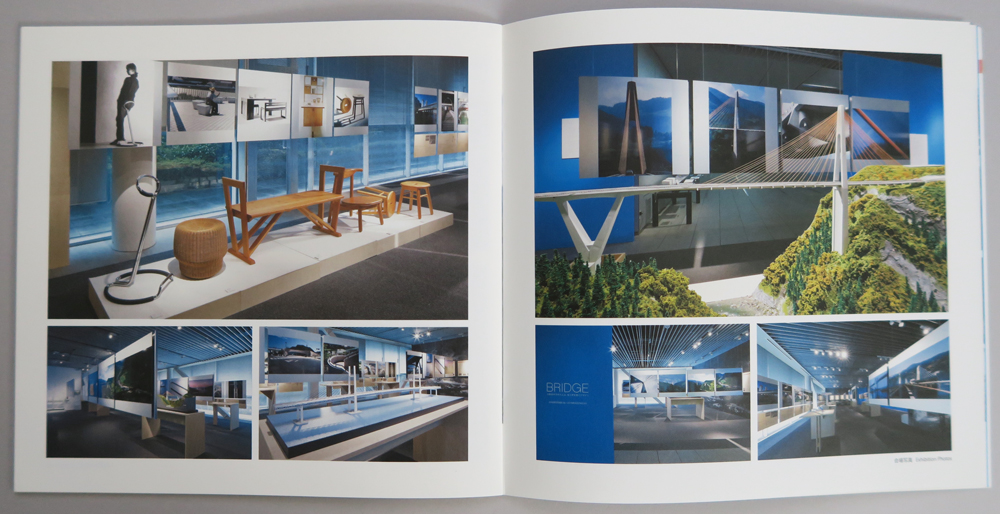
Exhibition view. From the catalogue of "BRIDGE: Miyoko Ohno no Hito to Hito, Maci to Maci o Tunagu Dezain".
ー Aside from the photographs of Ms. Ohno and Mr. Fujitsuka, are there any other sketches, drawings or models that were donated to Tama Art University?
Ikegami When she started work on the bridge project, I also gave them a study of how she conceived and thought about the project. I included a simple shape drawing in it. Other items include newspaper and magazine articles, books and exhibition pamphlets.
The models were disposed of because they took up too much space, and very few sketches remained. There were barely a few sketchbooks from her student days and when she started working, so I donated them to Tama Art University, and they were delighted. After she became busy with her work, she started to draw sketches and then immediately throw them away.
ー The collection of works, "BRIDGE: Fukei o Tsukuru Hasi", also has an archival element, as it is a compilation of her representative bridge projects.
Ikegami There were many photographs taken by Mr. Fujitsuka, and Ohno wanted to compile them into a book, but she was too busy to work on it. One day, someone from KAJIMA INSTITUTE PUBLISHING approached her about a book, and she said it took about three years before someone from KAJIMA INSTITUTE PUBLISHING came and discussed various things with her and she started working on it. When Ohno consulted Mr. Fujitsuka, he introduced her to a graphic designer, Ms. Miya Suwa, who made a sample for Ohno, saying that this was the kind of image she wanted to create. It took five years from the time the publishers approached her, but I think it was good for Ohno to be able to see things in concrete terms and to be able to talk about them.
Then, for quite some time, Ohno had asked me to write a book about what she had written so far for newspapers and magazines, but I was too busy with my daily work to make any progress. After Ohno passed away, I and the remaining staff compiled them into a collection of manuscripts called "Sutsuru kara Buriji made", which we distributed to the people concerned.
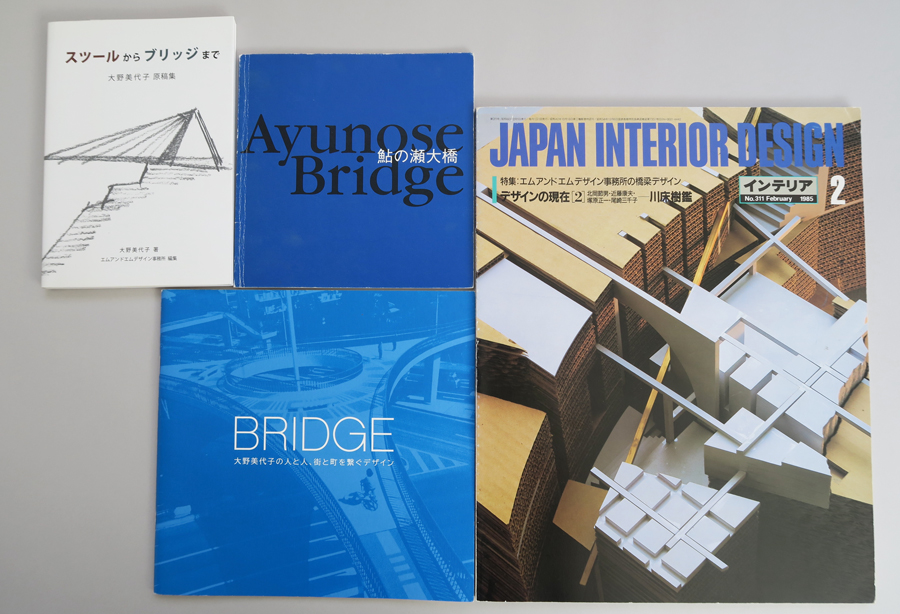
The manuscript collections "Sutsuru kara Buriji made" and "Ayunose Oohasi", the exhibition catalogue "BRIDGE: Miyoko Ohno no Hito to Hito, Maci to Maci o Tunagu Dezain", and a feature in JAPAN INTERIOR DESIGN (February 1985 issue, Interior Publishing) entitled "M&M Design A special feature titled "Bridge Design by the Office" was published.
Produced files on civil engineering and furniture work
ー Did you also donate the furniture to Tama Art University?
Ikegami I did not speak to Tama Art University about the furniture, as I was not sure if they would accept it as it takes up a lot of space. The furniture is now at Ohno's house in Kansai. Ohno usually lived in Tokyo and would visit the house during summer and New Year holidays, but moved there after she became ill. There, Ohno designed furniture, including a rattan stool that was a graduation project of Tama Art University, which is now being used by her two sisters. I don't know what will happen to those pieces of furniture in the future.
Another thing, together with the remaining staff after Ohno passed away, I also donated a file and its data to Tama Art University, including a biography, a chronology of her work and a page-by-page summary of his work, mainly in civil engineering and furniture. The summary text below the photos was written by Ohno and quoted or added to by me. The bridge projects include footbridges, road bridges, motorway bridges and railway bridges, and the other civil engineering work is divided into genres such as protective fences, sound barriers, tunnel drags and furniture, arranged in chronological order. I knew I needed something that covered all the work Ohno and the M&M Design Office had done, so it took a lot of time and effort, but I'm glad I made it.
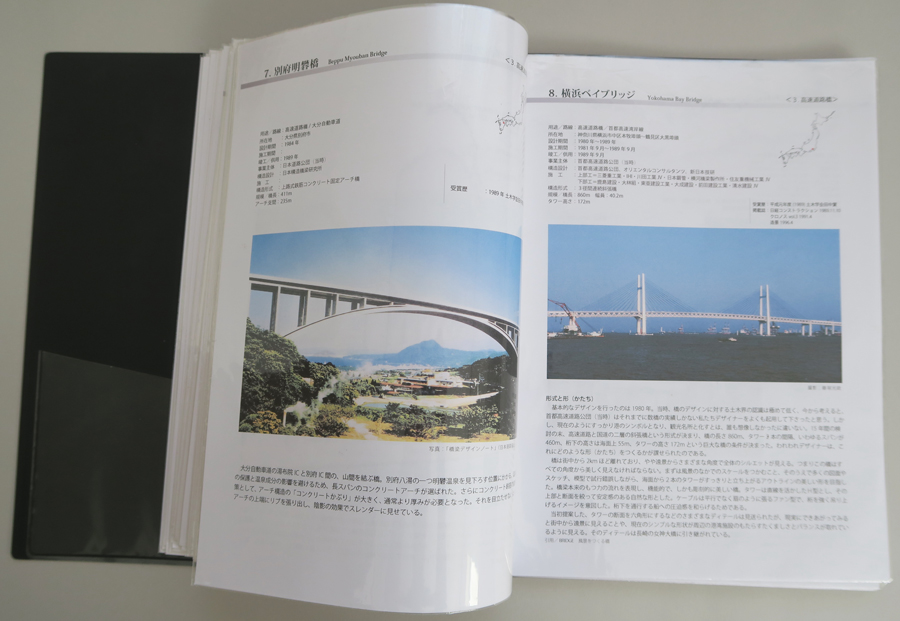
Files on civil engineering and furniture work
ー This file gives you an overview of Ms. Ohno's work in civil engineering and furniture. Many designers who do not publish books often lose track of who they were and what they did after they pass away, but Ms. Ohno is lucky that Ms. Ikegami and the rest of the staff have been able to put it all together. By the way, she also designed the road barriers and sound insulation walls.
Ikegami The design of the road barriers was another job Ohno wanted to do. The general barrier was a white guardrail, but the Tohoku Regional Bureau of the then Ministry of Construction thought it was necessary to create a more landscape-friendly and beautiful barrier, so they invited manufacturers to submit technical proposals in a competition. KOBELCO METAL PRODUCTS (now NIPPON STEEL KOBELCO METAL PRODUCTS) was selected and Ohno was in charge of the design. This was realised and is now being rolled out nationwide. It was designed with the idea that it should look like a beautiful landscape, both from travelling vehicles and from pedestrians' point of view.
Sound barriers were another job Ohno wanted to do, and the Metropolitan Expressway Public Corporation also wanted to do something about them because they were big and prominent, so they approached Ohno and she realised some of them. Then she also worked on refreshment parks with care design, underpasses and tunnel entrances. Ohno felt like she had a mission to clean up the various things in the city one by one, and she worked very hard to get the work she wanted to do.
She also wanted to do more care design work, and in the collection "BRIDGE" you can see small bridges in cities that Ohno photographed abroad, and she wanted to work on small bridges that support people's daily lives.
ー This is a bit of a change of subject, but Ms. Ohno was asked to design a monument for the Tanaka Award of the Japan Society of Civil Engineers, and Mr. Ryohei Kojima did the graphic design for it.
Ikegami Mr. Kojima was a fellow student of mine from my preparatory school days, and they were good friends, casually asking him to do various things. I was inwardly worried, though, about whether it was right to ask him to do such a job. For example, in the 1970s, when Ohno designed the interior of a shop, she asked him to do everything from the logo on the sign to the graphics on the small matchcases used for advertising. In the late 1970s, the Metropolitan Expressway Public Corporation set up a study group on landscapes led by young people, and asked him to design the cover of a report entitled "Keikan (Landscape)" that summarised its contents. Although the content of the report was solid, the cover was sophisticated and beautiful, and the civil engineers in the study group were delighted with it.
The most surprising thing was that the logo design for the "Yokohama Bay Bridge" promenade, SKY WALK, was selected from a public competition for primary schools students in Yokohama City, and Mr. Kojima beautifully arranged the design. Ohno was bold enough to ask him to do such a great job, and I don't think he paid him that much in guarantees, but Mr. Kojima was always willing to do it, and all the designs were really very beautiful.
ー That is a valuable story as archive material information for Mr. Kojima. Did any of these materials remain?
Ikegami No matchcases or other materials remained, but the Metropolitan Expressway Public Corporation's report "Keikan (Landscape)" was in our office, although the binding was quite tattered, so this was also donated to Tama Art University.
These Ohno materials can be used as research materials by students. Last year, the Department of Environmental Design at Tama Art University, the University of Tokyo and the Faculty of Engineering at Hosei University conducted research into bridges around Tokyo that Ohno had worked on, and together with the results of this research, the exhibition included panels from the exhibition "BRIDGE: Miyoko Ohno no Hito to Hito, Maci to Maci o Tunagu". The panels from the exhibition and a model of the "Yokohama Bay Bridge" were borrowed from Gallery A4 and displayed. I hope that Ono's materials will continue to be used by students in this way.
ー I hope it will be utilised a lot in the future. We hope to have another opportunity to ask the Tama Art University Art Archives Center about Ms. Ohno's material. Thank you very much for your time today.
Enquiry:
Tama Art University Art Archives Center
https://aac.tamabi.ac.jp

